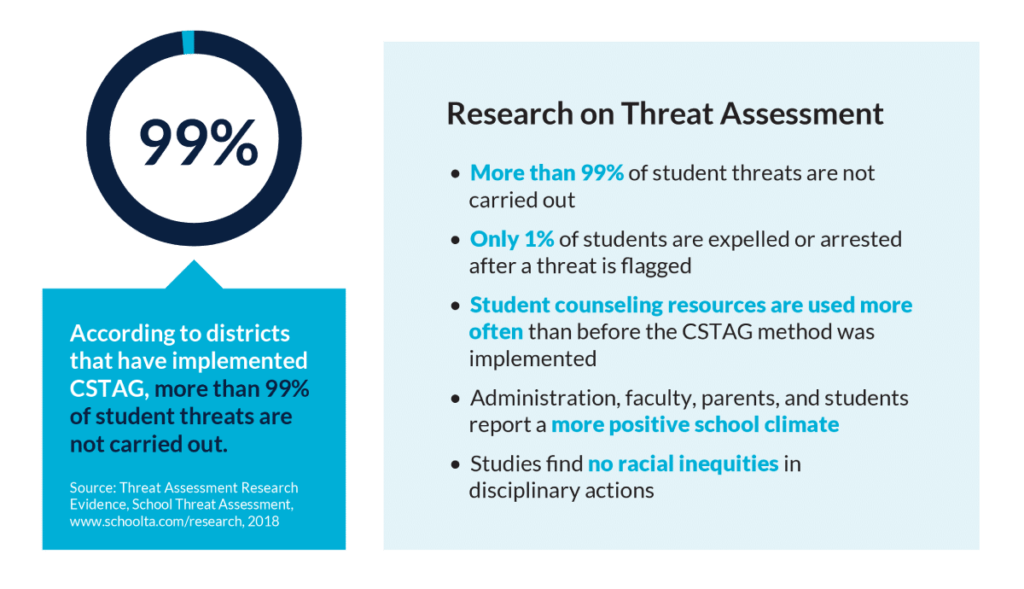Comprehensive School Threat Assessment
American schools face an epidemic of violence by and against their students. A 2019 government study found that 7% of high school students reported being threatened or injured with a weapon. In the same year, 5% of students aged 12-18 reported that they had feared bodily harm while at school. It is therefore unsurprising that, over the year, nearly half of America’s schools reported to the police an incident of student harm.
With the pandemic exacerbating the existing student mental health crisis, it is more urgent than ever that schools ensure they are prepared to identify—and mitigate—threats to student safety before harm occurs. To help schools do so effectively, Lightspeed Systems® invited Professor Dewey Cornell, Director of the Youth Violence Project at the University of Virginia, to discuss his revolutionary approach to student threat assessment: the Comprehensive School Threat Assessment Guidelines (CSTAG).
The history of threat assessments
In the wake of the Columbine massacre, the FBI investigated school shootings in the hopes of discovering what seemingly unrelated incidents had in common. What the agency found was that students who engaged in violence did so only after months of troubled behavior—and, crucially, that the students manifested similar behaviors before hurting others.
This finding implied that certain behaviors could be correlated with violence. Therefore, schools that could detect those behaviors in a student could intervene before harm occurred. As the agency worked with schools to identify these behaviors, they were determined to avoid overreacting and underreacting to the threats they perceived.
While the risk posed by underreacting is obvious, the risk from overreacting was less apparent but, according to Dr. Cornell, no less real. He related the story of a young student who nibbled his Poptart into the shape of a pistol and, after brandishing it at other students, found himself suspended. “This boy did not pose a serious risk of violence,” Dr. Cornell said, “but suspension can have a really devastating impact on a young person’s education.”
All the more reason, he explained, to ensure schools are accurate in their threat assessments.
How CSTAG helps schools protect students
In 2001, Dr. Cornell worked in concert with the FBI to turn their investigation into school shootings into the Comprehensive School Threat Assessment Guidelines (CSTAG). After field testing this threat assessment system in 35 schools, Dr. Cornell and his colleagues developed a decision tree to distinguish transient threats from substantive threats—and then to also issue guidance to districts on how best to intervene.
The core of CSTAG is a five-step process that school-based student threat assessment teams perform upon flagging a potential threat.
Step 1: Evaluate the threat. Team members gather as much information about the threat as possible, including the nature of the threat, the student’s history, and the context in which the threat emerged.
Step 2: Attempt resolution of a transient threat. The team follows a decision-tree to determine separate transient threats from substantive ones. If transient, the team sits down with the students involved to discuss and resolve the threat.
Step 3: Intervene in a substantive threat. At this stage, the team considers threats in which the student is demonstrating real intent. The district then intervenes, often in the form of counseling or conflict mediation.
Step 4: Conduct a thorough safety evaluation. At this stage, the teams are engaging threats they deem very serious substantive threats. Schools may now intervene by suspending students pending a mental health screening and possibly engaging law enforcement. The threat assessment team will also develop a safety plan that reduces risk and addresses student needs.
Step 5: Implement and monitor the safety plan. The team implements the safety plan developed at earlier steps in the process. The district monitors the student and works to improve the situation underlying the original threat.
CSTAG training, which is available nationwide (including online at www.schoolta.com), is fast becoming the national standard in threat assessment. Districts across the country—including every district in Florida—are using the CSTAG method, and more districts are adopting it all the time.
Why? Because the model works. Look at the stats from districts that have implemented CSTAG. Administrators have found that:

- More than 99% of student threats are not carried out
- Only 1% of students are expelled or arrested after a threat is flagged
- Student counseling resources are used more often than before the
CSTAG method was implemented - Administration, faculty, parents, and students report a more positive school climate
- Studies find no racial inequities in disciplinary actions
It’s particularly important to note how many assessed threats do not lead to disciplinary action but the provision of essential support services. “No young person is born violent or is destined to be violent,” Dr. Cornell stressed.
graphic showing CSTAG research data
“There’s always a combination of social, familial, and psychological factors behind violence. With hindsight, you can often see how violence could have been prevented, so the basic idea of threat assessment is to help people in distress.”
How technology can assist with student threat assessment
Technology can help districts protect students and the communities counting on schools to keep their children from harm. Because the FBI has determined that most students tip threatening behaviors through their online activity, districts should monitor students’ online activity for potential safety risks. Indeed, in an analysis conducted by the US Secret Service, 74% of school shooters displayed online indicators prior to the attack.
With real-time social media and email scanning and integration with chat functions including Microsoft Teams, sophisticated school online safety software such as Lightspeed Alert™ from Lightspeed Systems® gives IT teams, counselors, and school leaders direct visibility into online indicators of potentially dangerous or harmful student behavior.
Lightspeed Alert can be a critical component in student safety plans and the prevention of self-harm, suicide, and school violence. When a threat is detected, district administrators and trained Lightspeed Safety specialists are notified immediately as indicated by their threat assessment protocols. That means districts can be confident they swiftly and appropriately intervene before an incident occurs. The system securely maintains records of a student’s history and timeline of incidents, which can serve as critical documentation for the district’s follow-up efforts to address student mental and emotional health.
To learn more about Dr. Cornell and the Comprehensive School Threat Assessment Guidelines, watch our free webinar.
To ensure your district is alerted to potential threats to student welfare before an incident occurs, schedule a demo today to learn how Lightspeed Alert can protect your students.

